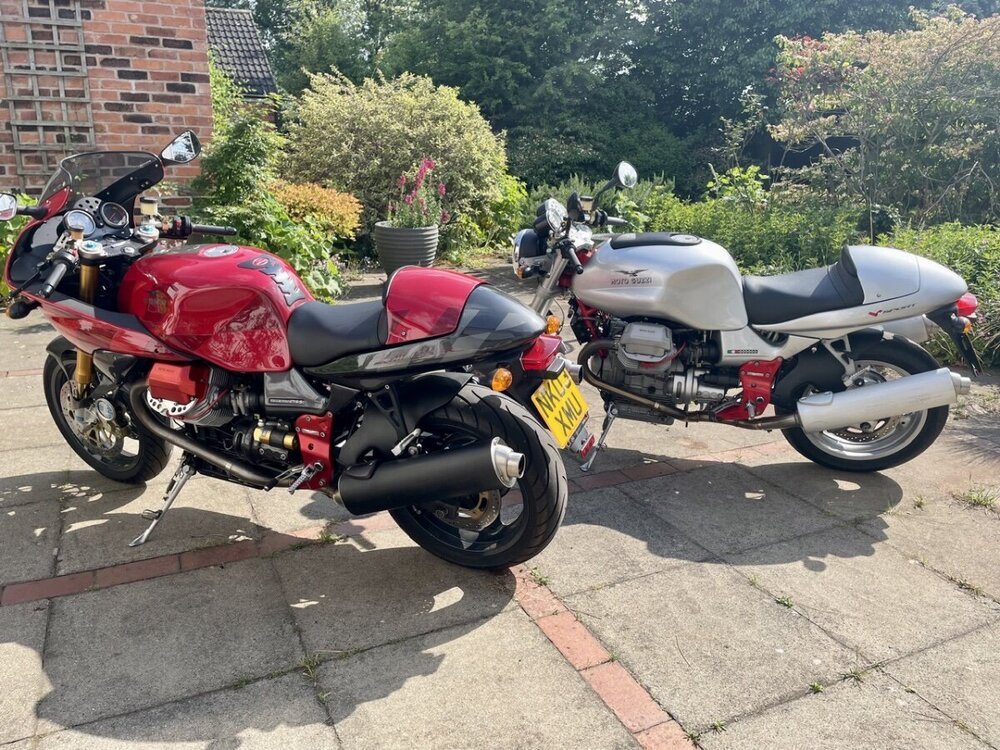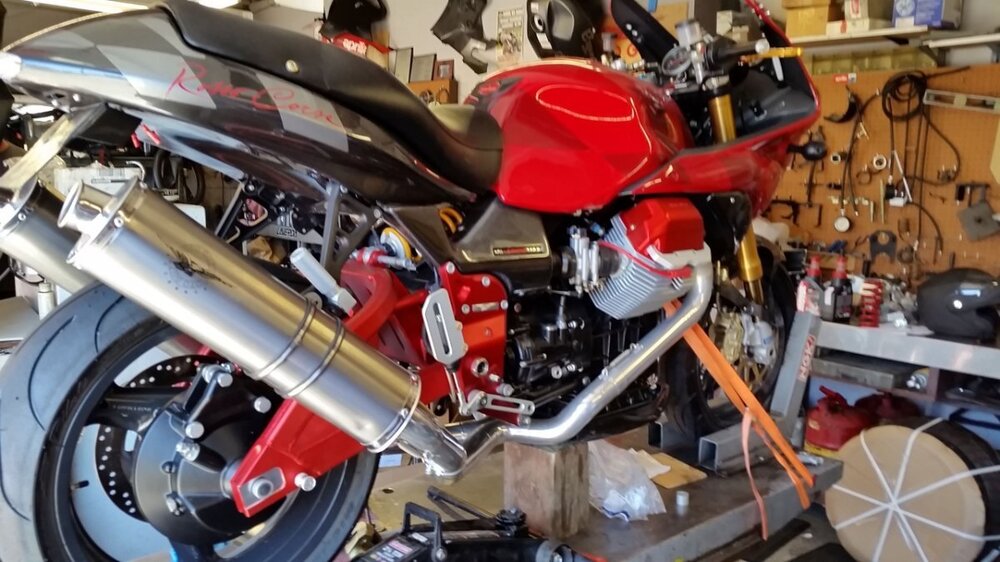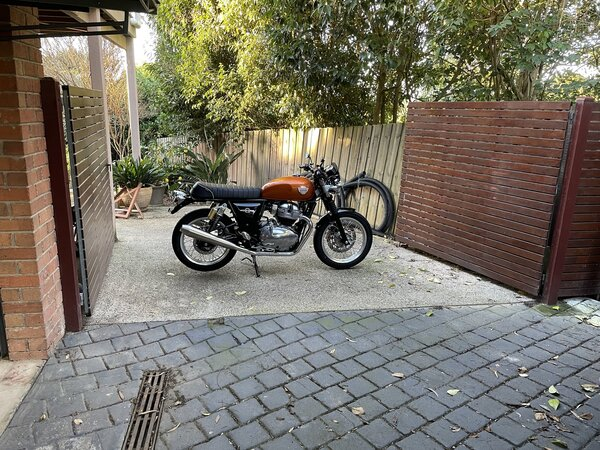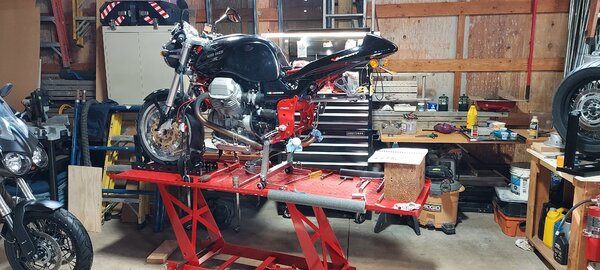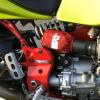Leaderboard
Popular Content
Showing content with the highest reputation on 07/14/2024 in all areas
-
5 points
-
Update on my friends search... After him reading, looking and listening to my suggestions, he settled on a new Ducati Monster Plus. He got it for a great price and it was delivered last week. He had to attend a MSF course to get his license endorsement. I went to his place yesterday to give it its initial break-in run since he is too green to do it at this stage. I think the bike is perfect for him. About 400 lbs wet, it is very flickable. Not sure I like the throttle by wire...it had a different feel to it, but could be the mode I was in. Lesson learned...when someone wants a red Ducati they will not be swayed. And yes, @p6x, sitting next to a red Ducati my Griso looks more orange than red.2 points
-
I have mySport because myWife said I should. One should not quibble with these sorts of directives . . .2 points
-
It should be no more than 14v . I will have to go and start mine up ...at rest battery v was 12.4v , after start-up it was like 12.8v. Blip your throttle a few times like 3k or above , At 3k I got 14.5v . AGM batteries are different. Keep this in mind! You always want to blip your throttle or hold it steady above 2500 for a few seconds for the regulator to start working . TRUST ME . I worked on a BMW car for 3 days after I replaced the alternator and it still would NOT charge . For some stupid reason I blipped the throttle and it started charging.1 point
-
1 point
-
1 point
-
Well , you tested a diode . There is more than that taking place in that little box . Get a new one just to test with . If it turns out good , I would buy the best (not most expensive) one available .1 point
-
When I was in the army, I was given the opportunity to apply to become one. Initially, it would have been riding horses, but with the objective to evolve to motorcycles. I was already riding both in my hay days... Those guys are military, not police. The video is in French but there are a lot of photos that you can scrub through. You will note they initially started to ride British before evolving to be BMW fanatics. I never learned to ride a horse the distinguished way, I did not even purchase the equipment. Sneakers and jeans, that's all it took. It took countless falls before I understood how to jump with a horse. I never thought it could be dangerous to take a tumble. Something you would not be able to do today. At this club, we were let loose in the forest without any supervision. If you fell, the horse would go back to the stables, and you would have to walk back. Lol!1 point
-
One of my best friends had a 320i that set a couple of years . he went to start it and the oil light would NOT go out . He would let it start/run a minute at a time and the light would never go out. I went to his house , removed the oil press. switch , had him start the car . In a few seconds , oil was going everywhere . Reinstalled the switch and closed the hood. These oil pressure switches are not hard to remove on these bikes . It is easier to remove than the engine. If your light will not go out in about 3 seconds , stop the bike and start troubleshooting.1 point
-
It was filled and started earlier today. The red oil light would have stayed on if there was no pressure I assume. Warmed it up and upped the rpm a bit, shut it down and turned ignition immediately back on. Oil pressure holds for 3 to 4 seconds, then light pops on again. Seems all is well. Won't do it that way again though. I thought I had the oil but I was wrong. Thanks for the tip.1 point
-
I've always used 850 ml as the fill volume (~30 ounces). You probably have this solved with flushing the gearbox well and correcting the fill volume.1 point
-
@cash1000 had foaming in his gearbox oil. He drained and refilled a few times before it stayed clear. We thought that it may be because of water getting into the oil, and the only path for water seemed to be the vent, which is in line with spray from the rear wheel. We both fitted a remote vent hose to avoid this. The vent plug thread is M6 x 1 mm.1 point
-
1 point
-
1 point
-
1 point
-
Yeah, I marked up my relays, fuses, etc. after seeing yours Doc but mine aren't as elegant.1 point
-
I labeled my relays like this: Yet, it is a must to know which fuse supplies each relay as "the rest of the story" is shown at the fuse block (inverted so as to read from the sidestand side of bike. Beside the road. While bewildered):1 point
-
Thank you ! While swapping out the fuses on both bikes , I found the 30a fuse on Greenie starting to melt the plastic on the fuse . SO , I start all over and bend the terminals on ALL connectors on ALL the fuse terminals and use a dab of NYE 750G "goo" to help the contact surfaces . I put the old fuses in a baggie and stuck them up in the hole behind the seat . When I got back from my trip to town I found the package from MG Cycle. Now I can install the pump , air filter and fuel shutoff . The strange thing about this shutoff , it does not need a 12 in pie wrench to turn the fuel off/on ! One of these days both of these bikes will be in riding condition !1 point
-
On airplanes, the cylinder needing checked is put at TDC compression stroke. The prop is dangerous and is held tightly before turning on the air. The regulator sets the first gauge at 80 psi, and the second gauge shows the leakage. The prop then can be turned back and forth a degree or so to get the highest reading. A normal cylinder will be 75 psi or above. I don't get terribly concerned until it reads 70 or under. This will show leakage from rings at the crankcase breather, intake valves at the carb, or exhaust valves at the (wait for it) exhaust stack. It won't tell anything about valve guides, but since it is at TDC you can feel how much clearance there is by wiggling them around. Edit: I would put an on/off valve on the hose to the cylinder on the pictured rig. It makes things simpler.1 point
-
Yah, BR6ES. I wasn't really riding that hard that day, but the temps were stupid hot. Pretty sure it heat soaked something (everything?) at the brief (6-8 minute) stop. @andy york Get yo' shiney-hiney to the SSR XX and we'll park the two highest mile V11 together for a comparo: pushing a half million kays between them . . .1 point
-
Pretty sure I rip it up and down the rev-range like a jackrabbit on hot lava. Might be pulling "too much" lube down the valve guides and up the cylinder walls . . .1 point
-
Like Chuck said. Looking at your plugs, mileage, some quide wear for sure. I was lucky, bent valve outside the garage idling. Machinist told me when milling out the quide on my right head, the quide just dropped out after minimum milling. Not trying to scare, just a wear thing. 215600km not bad at all. Don't think the unsceduled pit stop had anything to do with wear. Just some thoughts docc. Cheers Tom.1 point
-
134,000 miles, didn't you say? Some things don't heal themselves... If it gets urgent, I've got a brand new set of valves, and my motor has "only" (according to the speedo) got 65,000 km on it.1 point
-
1 point
-
Thanks, Chuck. I'll check around to see if I can find a tester locally. I only have a compression tester.1 point
-
1 point
-
1 point
-
1 point
-
1 point
-
1 point
-
+1 on the RE 650's bang for the buck I really like my 350 classic (& will not likely part with it) but a few extra horses would be nice to have out of town. With the Meteor and the new Shotgun it looks like they can make quite a few riders happy...1 point
-
1 point
-
1 point
-
Yes, it's an ESR515, which is available in two wire connection configurations for the V11 (pre 2003, and 2003+). I showed the wiring connector differences for pre and post 2003 models about a dozen or so posts above should you be interested. I did apply some dialectic grease after making the connections, so hopefully protected for a while anyway. Sent from my Pixel 4a using Tapatalk1 point
-
Another word against the small black wire guzzi provide, Some owners have experienced a poor connection on the main battery ground, in this case when you try to start the starter current tries to get back to the battery through the regulator ground turning it red hot which causes it to melt the insulation off other wires in the loom, I used to have a picture of that mess. On my 2001 the regulator was fitted to the horn bracket, nothing had been done to remove the paint from where the bracket contacted the chassis, A short wire from the regulator case to a timing cover screw takes care of all that..The other problem with the Ducti Energia regulator is it takes it's Voltage reference from the headlight circuit downstream of the headlight relay, that point can be anywhere from 0,6 to 1 Volt lower than the actual battery Voltage. Battery charge current vs Charging Voltage is some sort of exponential relationship so if you drop too much at the reference point you wind up with too much charge current and cook the regulator. IMHO you are much better to have a modern direct connect regulator even with its tiny leakage current. The modern V7s use a Chinese Shindengen regulator, I would use one of those before I bought another Ducati Energia. Look at Carl Allisons schematics on Greg Benders site, you will see the difference there.1 point
-
Ok, here is the reply from ElectroSport regarding charging and an extra ground: "You do not need to disconnect the reg/rect when charging. I suppose an additional ground might be helpful, I cannot see how it could hurt in any way, so it is a good idea. But I would not say it is required. Every reg/rect could benefit from additional ground connections but in most cases it would make no difference." Thank you, Kyle Wood - Sales Manager Procom Engineering / ElectroSport 21 Brookline, Aliso Viejo, CA 92656 PH: (949) 305-4200 www.electrosport.com Sent from my Pixel 4a using Tapatalk1 point
-
Once again the sage advice from this forum has saved me countless hours and probably some $$$. 3 weekends ago while riding my 03 Le Mans home I experienced fading dash lights, followed by a dying tach, and 5 miles later a backfiring engine. Didn't quite make it home. After checking the fuses, testing the Omrons, and then the alternator (thanks to all contributors in this topic!), it was clear that it was likely the regulator/rectifier. I placed my order with ElectroSport. But here's where I can make a small contribution - the Guzzi OEM regulator/rectifier changed in early 03, and has different connectors and no low voltage warning light (see attached photos from MG Cycle website). I sent these photos to Kyle at ElectroSport and followed up with a call. Their 03 version did not come with these connectors stock, but he was happy to modify it for me, and also tie-off the accessory wires for the warning light. So it was 100% plug and play when it arrived. I installed it Saturday and after a 90 miles ride my Odyssey battery measured 12.63v - seems all is good. Thanks again to everyone for making this a simple repair! Sent from my Pixel 4a using Tapatalk1 point
-
Wow, Kiwi_Roy, exhaustive. I replaced the regulator after navigating through the V11lemans Tutorial Committee's advice and my bike is on the road and only needed human power for propulsion once since, a few days ago, when I ran it out of fuel. It has trained me well in the art pushing it around. I'm beginning to believe it learned a few tricks in an S & M dungeon and I'm its rube. I discovered a fried black wire in the harness under the seat a while back and appealed to the collective wisdom implicit here and ran a more robust wire from the regulator to ground. The electrical system seemed good enough to earn a grade of D, graded on a curve, in a class filled with Moto Guzzi addicts; until the regulator quit, was replaced and here I am still crying into my beer to anyone who'll listen. But it runs, only if I give it a drink of gasoline, but it is running. Almost overwhelming, the well written detail in your post. I do have a battery drain, it would be nice if I could vanquish it. I will cajole a friend who's education exceeds my kindergarten diploma in electrical/electronic summer camp to read over my shoulder and parse what you're recommending. He'll sketch a few illustrations in cartoon form and I'll get it. Thank you.1 point
-
John asked me to look in on this thread, I used to know quite a bit about these systems. Firstly the alternator wires can be a problem, they snap off where they solder to the coils. When this happened to mine the copper was so corroded it was not possible to re-solder them so time for some new wires, its quite easy to solder the new copper to the coils. The bullet connectors where the regulator plugs into the stator leads often overheat, if this is a problem just chop the bullet connectors off and join to the alternator with crimp links or a solder joint. Grounding the regulator is critical, all the charging current travels back from the chassis to the regulator case so it can return to the alternator through the other yellow wire. The factory supply a small black wire from the case all the way to battery negative but this is far too small for the current involved. Run a short wire from the regulator case to a timing cover screw, the engine and battery main ground are massive compared to the tiny black wire. The regulator has a rectifier set up as a bridge, 2 diodes and 2 Silicon Controlled Rectifiers. The rectifiers sometimes go open circuit, this situation is very easy to set for if you have a meter with the diode test function, The diodes are connected from each yellow wire to the red wire, it should show about 0.5 Volt, since the diodes are between each yellow wire and the red pair its possible to add a diode on the outside. The way they measure the battery Voltage is very poor, it taps off the feed to the headlight after the headlight relay and in some cases a normally closed contact of the start relay. The relay contact and socket resistance changes with time, the Voltage drop can be anything from 0.6 to 1 Volt, I have a theory that the reference voltage drop approaches 1 Voltmeaning the battery Voltage has to be pushed above 15 to supply the regulator reference, this high Voltage demands more current which overheats the diodes unit the leads melt off. A warning sign can be the headlight out or the tachometer not working, chances are the battery is not charging and of course the charge light also fed from the headlight relay won't be working either fooling you into thinking everything is ok. I often thought of getting the Voltage reference from a different source downstream of the ignition switch, off one of the ECU relays or from a dedicated relay direct from the battery. This would give the regulator a lower Voltage reference because it expects a drop through the relay but it could easily be compensated for with some resistance ora diode in series. I struggled with this flakey Voltage reference for years then I upgraded to a permanently connected regulator from Electrosport, there was one minor drawback a parasitic drain on the battery, I used to disconnect the regulator over the winter but if you don't remember to re-connect it next thing you know the bike dies with a flat battery. Electrosport recommend their ESR515, I dont agree, it still relies on the flakey Voltage reference and a good ground connection. I used the ESR510 it is wired direct to the battery and it has a dedicated ground wire I don't think it supports the charge light. Instead of a charge light I recommend just purchase a battery Voltmeter for ~ $15 and hook it downstream of the ignition switch this will leave you in no doubt. https://www.amazon.com/12V-Voltmeter-Color-Digital-Display/dp/B07HHTZ1L5/ref=sr_1_46?dchild=1&keywords=12+volt+battery+meter&qid=1633586264&sr=8-461 point
-
I did visually inspect all the fuses at the onset. All seem to be in order. No sign of any burning etc. Checked the 30amper for continuity and all good. I ordered a new regulator.1 point
-
Great news! Those voltages are solid. Regulator time! Take time to run a dedicated ground wire from the regulator case to the timing chest of the motor.1 point
-
Hi, kids. They booted me from nursery school early, so I'm back with chapter . . . I haven't kept track, but it's nearing War and Peace level page count. I did as was suggested and checked output with yellow alternator wires isolated from the wiring harness of the bike. 18v AC at idle 45v AC at 3,000rpm 65-ish at higher rpm, prlly about 5,000, I hate spinning a motor at rest high, don't know why. This seems to comport with what is specced for it and indicates the alternator is functional? Would this point to the regulator?1 point
-
Last thing from me If that was AC Volts and not DC Volts then it's definately defective, ideally the test is carried out using a good quality meter. In the thread docc pointed to you can see warnings about cheap meters having problems with AC ranges. If the meter was set on DC Volts I'd expect a small reading as there usually is a small DC component. EDIT Thinking about this some more I realized you still had the alternator connected to the Reg/Reg when you took the 3.5-4.5V measurement, if I understood you earlier. The Voltage test needs to be conducted with the Alternator "Open Circuit" (in other words disconnected from the Reg/Rec), so no idea what voltage to expect measuring that way. This is from the Centauro manual but I'm pretty sure the V11 runs the same alternator Alternator With the engine switched off, disconnect the two yellow generator cables from the rest of the system and then carry out the following tests with a ohmmeter: Check the winding isolation towards earth Connect one connecting point of the ohmmeter to one of the two yellow cables and the other connecting point to earth (laminar pack). The instrument should indicate a value above 10 M Check the winding continuity Connect the two connecting points of the ohmmeter to the two yellow cables. The instrument should indicate a value of 0.2÷0.3 . Good Luck with it, it does sound like it's defective and you're well on the way to getting it repaired1 point
-
1 point
-
Reminds me of Japanese bikes' JIS screws getting the Phillips treatment.1 point



.thumb.jpg.91a67db8641cea72590980876d22ff5a.jpg)




.thumb.jpg.3dcc565878cbad1fcd32552bf3a24269.jpg)
.thumb.jpg.d80d80c6cb9005a05feca0250808f1c2.jpg)



